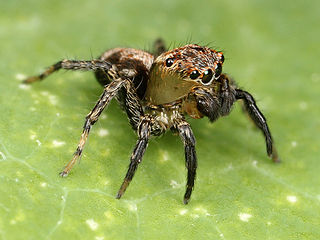
Nicylla is a monotypic genus of Sumatran jumping spiders containing the single species, Nicylla sundevalli. It was first described by Tamerlan Thorell in 1890, and is only found on Sumatra. Briefly considered a synonym of Thiania, it was elevated back to genus status in 2017.
Panachraesta is a monotypic genus of Sri Lankan jumping spiders containing the single species, Panachraesta paludosa. It was first described by Eugène Louis Simon in 1900, and is only found in Sri Lanka. Until 2016, it was a synonym of Myrmarachne.
Thianitara is a genus of Southeast Asian jumping spiders that was first described by Eugène Louis Simon in 1903. As of August 2019 it contains only two species, found in Thailand, Indonesia, and Malaysia: T. spectrum and T. thailandica. It was briefly considered a junior synonym of Thiania until 2017, when it was revived by Jerzy Prószyński.
Wallaba is a monotypic genus of Guyanese jumping spiders containing the single species, Wallaba metallica. It was first described by Cândido Firmino de Mello-Leitão in 1940, and is found in Guyana. It was synonymized with Sidusa in 2015, but was revalidated by Jerzy Prószyński in 2017.

Salticinae is a subfamily of jumping spiders. It includes over 90% of the known species of jumping spiders. The subfamily is divided into two unranked clades: Amycoida and Salticoida.

Simonellini is a tribe of spiders belonging to the Amycoida clade of the subfamily Salticinae of the family Salticidae. The group has been treated at a variety of formal and informal ranks, with different circumscriptions, including as the subfamilies Synemosyninae and Simonellinae. Its species mimic ants and beetles.
Emertonius is a genus of spiders in the jumping spider family Salticidae.
Ragatinus is a genus of spiders in the family Salticidae. It was first described in 2016 by Angelika Dawidowicz and Wanda Wesołowska. As of 2017, it contains only one species, Ragatinus maddisoni.
Nepalicius is a genus of spiders in the family Salticidae. It was first described in 2016 by Prószyński. As of 2017, it contains 3 species.
Okinawicius is a genus of spiders in the family Salticidae. It was first described in 2016 by Prószyński. As of 2017, it contains 9 species.
Psenuc is a genus of spiders in the family Salticidae. It was first described in 2016 by Prószyński. As of 2017, it contains 11 species.
Nandicius is a genus of spiders in the family Salticidae. It was first described in 2016 by Jerzy Prószyński. As of 2017, it contains 7 Asian species.
Papuaneon is a genus of spiders in the family Salticidae. It was first described in 2016 by Maddison. As of 2017, it contains only one species, Papuaneon tualapa, found in Papua New Guinea. It is placed in the tribe Neonini, part of the Salticoida clade of the subfamily Salticinae.
Orcevia is a genus of Asian jumping spiders that was first described by Tamerlan Thorell in 1890. It was once considered a synonym of Laufeia, but it was revalidated in 2019.
Tartamura is a genus of South American jumping spiders first described by A. A. Bustamante & Gustavo Rodrigo Sanches Ruiz in 2017. Tartamura was placed in the tribe Thiodinini, part of the Amycoida clade of the subfamily Salticinae in Maddison's 2015 classification of the family Salticidae.
Padillothorax is a genus of southeastern Asian jumping spiders first described by Eugène Simon in 1901. As of April 2019 it contains only two species.

Amycoida is an unranked clade of the jumping spider family Salticidae. It is the smaller and less widespread of the two subdivisions of the "typical" jumping spiders, occurring mainly in the New World, particularly the Amazon basin. Its sister clade is the Salticoida.
Agorioides is a genus of spiders in the jumping spider family Salticidae. The two described species are native to Papua New Guinea.
Leviea is a genus of spiders in the jumping spider family Salticidae. The three described species are all native to Papua New Guinea.
Papuamyr is a genus of spiders in the jumping spider family Salticidae. The two described species are all native to Papua New Guinea.




